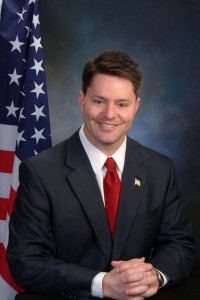 In the early 1990s, Democrats dominated both houses of the Missouri Legislature. State Senator Danny Stapleswas a typical member of the majority party: an old-school pro-gun, pro-life Democrat from southeast Missouri who operated a resort on the Jack’s Fork River. He hailed from Eminence (pop. 600) and explained his aggressive political style thusly: “Ya don’t get nuthin from the Sears catalog ‘less ya ask for it.”
In the early 1990s, Democrats dominated both houses of the Missouri Legislature. State Senator Danny Stapleswas a typical member of the majority party: an old-school pro-gun, pro-life Democrat from southeast Missouri who operated a resort on the Jack’s Fork River. He hailed from Eminence (pop. 600) and explained his aggressive political style thusly: “Ya don’t get nuthin from the Sears catalog ‘less ya ask for it.”
But in 1992, Missouri voters passed a law limiting legislators to eight years in each chamber. Current legislators weren’t grandfathered, and so incumbents’ days were numbered.
Rodney Jetton didn’t vote on the term limits law. In 1992, he was a 24-year-old Marine stationed in the Middle East. The son of a Baptist preacher in rural Marble Hill (pop. 1,502), he hoped to seek office upon returning stateside. In 2000 — the year that the full impact of term limits kicked in — the ambitious young firebrand won a seat in the House. More than half the representatives elected that year were freshmen, and most were Republicans. After nearly 50 years in the wilderness, Republicans had a shot to regain the majority.
Jetton wasn’t your typical freshman. He boarded the bus for the ritual freshman state tour with a 100-page document in his hand that he immediately presented to Minority Leader Catherine Hanaway. It was a plan to retake the majority. He forecast which districts were winnable and which weren’t. He broke down how much money it would take to win them. And he offered a roadmap for how to do it: emphasize guns and abortion to woo socially conservative Democrats like those who had long supported Sen. Staples, and use tort reform to dry up corporate contributions to Democrats (and eventually, to drain the coffers of trial attorneys). Hanaway, no dummy, recognized native political talent when she saw it. She put Jetton in charge of candidate recruitment and training.
 Jetton recognized something very important: The old-line Democrats like Staples were respected in their communities. These were communities in Northeast and Southeast Missouri full of people like Staples: farmers and small businessmen, laborers and tradesmen, mostly descended from the hardscrabble Virginians who had trekked across the hills long ago. They were Democrats because that’s what you were if you lived in Virginia before the Civil War. These yellow-dog Democrats coalesced with Democrats from St. Louis and Kansas City to provide durable statewide majorities for most of the 20th century, with Republican strength concentrated in the Bible Belt counties in Southwest Missouri.
Jetton recognized something very important: The old-line Democrats like Staples were respected in their communities. These were communities in Northeast and Southeast Missouri full of people like Staples: farmers and small businessmen, laborers and tradesmen, mostly descended from the hardscrabble Virginians who had trekked across the hills long ago. They were Democrats because that’s what you were if you lived in Virginia before the Civil War. These yellow-dog Democrats coalesced with Democrats from St. Louis and Kansas City to provide durable statewide majorities for most of the 20th century, with Republican strength concentrated in the Bible Belt counties in Southwest Missouri.
The more retrograde the political debate, the more progressives left or never came in the first place. And the more progressives left or stayed away, the more conservative the electorate became, and the more reactionary the debate.
But by 2000, times were changing. As many scholars and journalists have chronicled, the national Democratic Party had, since the mid-1960s, increasingly lost touch with the old-line Democrats, who continued supporting local Democrats but had long since stopped backing them at the national level. Jetton intuitively understood that the way to these men’s political hearts was through their gun racks. And he knew that the way to their wives’ hearts’ was through the local preacher — that’s where the life issue came in. He established a clear partisan cleavage on cultural issues that, until then, had existed only in federal and statewide elections. In just two years, he went from minority-party backbencher to speaker pro tem.
In order to solidify this new cleavage, Jetton needed interest groups like the NRA, Missouri Right to Life (MRL), and the Missouri Family Network. They helped, but their support did not come cheap. The NRA, for instance, first demanded passage of concealed-carry legislation. But that proved insufficient, and the group ultimately spearheaded passage of a so-called “castle law” that even allows drivers to shoot (and kill) anyone who reaches into their vehicle.
MRL wanted to ban the procedure conservatives call partial-birth abortion. Then they wanted parental consent, and worked to make it so cumbersome for abortion clinics to operate that nearly every one in the state had to close. Missouri soon had some of the strictest abortion laws in the nation. Still not satisfied, MRL sought to criminalize scientific research on stem cells.
No hot-button cultural issue escaped attention. Laws prohibiting gay marriage were now deemed insufficient, so Republicans demanded a redundant constitutional amendment (which garnered 72 percent of the vote). It wasn’t enough to crack down on undocumented immigrants in the workplace. Republicans demanded a constitutional amendment making English the state’s official language, though there was no evidence anyone had ever conducted state business in any other language (until, of course, the day I filibustered that proposed amendment in French).
Jetton, who became speaker in 2007, could not always meet these insatiable interest group demands, thanks to a few recalcitrant liberal senators (of whom I was one). But after a couple years I realized that by filibustering issues like English-only, I was playing right into his hands: The longer newspapers featured liberal Democrats fighting for the right to speak French, the better Republicans would do. Jetton didn’t really care whether it passed or not. (Ultimately it did, with 86 percent of the vote — not exactly a state welcome mat for Latinos and other immigrants.)
Each of these laws accomplished two things, politically speaking: (1) they repelled gays and LGBT allies, immigrants and those who appreciate diversity, scientific researchers and young, mobile progressives, and discouraged new ones from coming to the state; and (2) helped retain and attract people with conservative world-views. It was a vicious cycle: The more retrograde the political debate, the more progressives left Missouri or decided against coming there in the first place. And the more progressives left or stayed away, the more conservative the electorate became, and the more reactionary the debate.
And therein lay the problem for Missouri, a former bellwether state which is now so conservative that a guy who believes women who are raped can “shut that whole thing down” to prevent pregnancy is polling even with a centrist incumbent U.S. senator. The more progressives heard the state’s often-nutty political debates, the more they voted with their feet. For instance, after a fierce debate that led the state in 2006 to narrowly (51-49) uphold the right to perform embryonic stem cell research, research institutes in St. Louis lost top-flight researchers and began to struggle to attract new ones from other states thanks to the “persistent negative political climate,” as the Stowers Institute for Medical Research put it when deciding against expanding research in the state.
There is one other major factor in Missouri’s political shift: two opposing population shifts. The first is widely known: a mass exodus from St. Louis. Once the nation’s fourth-largest city, teeming with 900,000 people, the city’s overreliance on disappearing auto industry jobs led to a steep decline. The city now has 320,000 residents, a larger proportional loss than Detroit’s. Much of the city’s population has fled to exurban St. Charles County, which is now larger than the city and typically provides the state’s largest Republican turnout.
The other population shift is less well-known: the runaway growth of several counties around in south-central and southwest Missouri. Some Atlantic readers may not have heard of Branson, despite (or perhaps because of) the fact that it is billed as the “live country music capital of the world.” Situated on the Lake of the Ozarks, Branson had long been a popular vacation spot for Midwesterners. But construction of music theaters by nationally known stars like Conway Twitty and Loretta Lynn in the 1980s and 1990s helped Branson transform itself into a major tourist attraction — and a retirement mecca for country fans. The influence of Christian conservatism in this thriving area continues to grow.
My doctoral thesis argued that a partisan realignment must comprise two elements: (1) a newly dominant issue cleavage and (2) a transformation not of political preferences generally but of the way that people holding those preferences align by party. Missouri was always a culturally conservative state outside of its two major cities and, to some extent, even inside them. But Jetton’s strategy wooed rural and exurban social conservatives, helping expand his party’s base along new issue cleavage lines.
Like me, Jetton has had his share of ups and downs since leaving the legislature. But his successors have emulated his deft ability to drive wedges between urban and rural Democrats; in fact, the House Republicans need just a three-seat pickup this fall to render their 106-55 majority veto-proof. And the dominant Senate Republicans (26-8) have effectively isolated Democrats to Missouri’s East and West Coasts (5 seats in St. Louis and 3 in Kansas City), such that a map of Senate representation in the state eerily resembles the famously divided Bush-Gore Electoral College results that provoked so much commentary about a culture war. While the same term limits so critical to his rise forced Jetton from office years ago, his legacy lives on.
(Cross-posted, with permission of the author, from Atlantic.com)









Leave a Reply